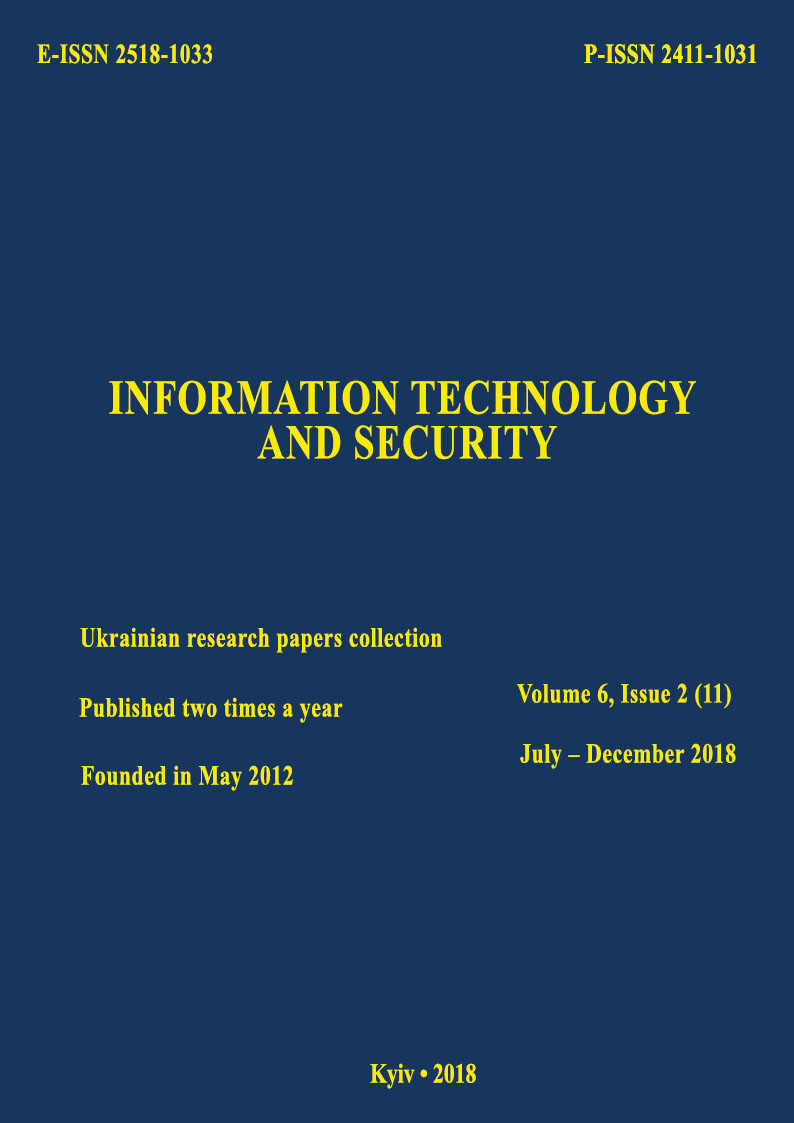Analysis of stability of the user’s keyboard handwriting characteristics in the biometric authentication systems
DOI:
https://doi.org/10.20535/2411-1031.2018.6.2.153487Keywords:
Authentication, biometric user authentication, biometric characteristics, keyboard handwriting, biometric authentication system.Abstract
Consideration is given to the use of biometric characteristics in order to increase the efficiency of user authentication. An identifier that uses biometric characteristics is inextricably linked to the user, and it is virtually impossible to use it unauthorized. As a biometric characteristic it is expedient to use a keyboard handwriting. Keyboard handwriting, or rhythm of typing, displays a way of typing on a keyboard that is specific to a particular user. In addition, it is quite simple to implement and does not require additional hardware costs. Moreover, the use of keyboard writing when entering a password eliminates the main disadvantages of classical password systems and systems based on access cards. The focus of the research was on the sustainability of the time characteristics of the keyboard handwriting of a particular user over a long period of time. To implement the admission of the user to the computer system, an algorithm based on the Heming distance is selected. According to the chosen algorithm an algorithm for forming a vector of biometric characteristics of the user is developed, which includes the duration of holding a specific key and the time between pressing the neighboring keys. An algorithm for forming a user's biometric standard is developed. To analyze the use of keyboard handwriting, software applications that implement the user's access based on keyboard handwriting were developed, as well as a program for collecting time characteristics. Both applications use the developed algorithms. To study the constancy of handwriting time characteristics, an empirical study was conducted. For this purpose, a group of individuals is selected, each of which has a computer input at an adequate level. They all entered the proposed phrase within a year. The obtained statistical data, on the basis of which, the average values and values of the average square deviation of the time characteristics of keyboard handwriting at the various time intervals are calculated. Estimated probability of correct user recognition by its frequency in n independent experiments. As a result of the study, the persistence of user keyboard handwriting as a biometric characteristic for use in computer data protection systems, in particular, authentication systems, was analyzed.
References
I. Kazantsev, “Analysis of keyboard writing in the processes of authentication, identification and discovery of operator substitution”, Young scientist, vol. 1, no. 9, pp. 167-169, 2016.
V. Yevetskiy, and I. Horniichuk, “Use of keyboard handwriting in user authentication systems”, Information Technology and Security, vol. 4, iss. 1, pp. 27-33, 2016.
S. Yengalichev, and S. Semenov, “Biometric authentication based on the analysis of keyboard writing”, Applied electronics, vol. 11, no. 2, pp. 309-311, 2012.
B. Bukhtiarov, and V. Abashin, “Systems of biometric authentication of the user of the PC by the keyboard handwriting”, Week of science, vol. 4, no. 1, pp. 172-174, 2013.
A. Kaluzhin, and D. Ruder, “Confirmation of the personality of the user by his keyboard handwriting”, Izvestiya Altay State University, vol. 1, no. 85, pp. 158-162, 2015. doi:10.14258/izvasu(2015)1.1-28.
V. Grigoriev, and A. Nikitin, “Use of stationary methods for biometric identification of the user”, Bulletin of the RSUU, vol. 1, no. 94, pp. 135-143, 2012.
V. Yevetskiy, “Evaluating the effectiveness of individual attributes and their aggregates for individual recognition of objects”, Information Technology and Security, vol. 3, iss. 1,
pp. 132-137, 2015.
Hamming distance. [Online]. Available: https://ru.wikipedia.org/wiki/Расстояние_Хэмминга.
I. Sidorkina, and A. Savinov, “Three algorithms for access control to ksiya on the basis of recognition of keyboard operator handwriting”, Herald of Chuvash University, vol. 1, no. 3, pp. 293-301, 2013.
I. Aguryanov, “Keyboard writing as a means of authentication” [Online]. Available: https://www.securitylab.ru/blog/personal/aguryanov/29985.php.
Authentication Solutions Through Keystroke Dynamics. Info security products guide published from silicon valley. [Online]. Available: http://www.infosecurityproductsguide.com/ technology/2007/BioPassword_Authentication_Solutions_Whitepaper_FINAL.pdf.
E. Ventsel, Theory of probabilities. Moscow, USSR: Nauka, 1969.
А. Ivanov, Biometric person identification based on subliminal dynamic movements. Pensa, Russia: Pensa university, 2000.
V. Yevetskiy, and I. Horniichuk, “Certificate of registration of copyright for a work “Computer program for user authentication by means of keyboard writing”, State Service of Intellectual Property of Ukraine No.71533, Apr. 19, 2017.
V. Yevetskiy, and I. Horniichuk, “Certificate of registration of copyright for a work “Computer program for user registration for authoring means of keyboard writing”, State Service of Intellectual Property of Ukraine No. 71534, Apr. 19, 2017.
Downloads
Published
How to Cite
Issue
Section
License
Copyright (c) 2020 Collection "Information technology and security"

This work is licensed under a Creative Commons Attribution 4.0 International License.
The authors that are published in this collection, agree to the following terms:
- The authors reserve the right to authorship of their work and pass the collection right of first publication this work is licensed under the Creative Commons Attribution License, which allows others to freely distribute the published work with the obligatory reference to the authors of the original work and the first publication of the work in this collection.
- The authors have the right to conclude an agreement on exclusive distribution of the work in the form in which it was published this anthology (for example, to place the work in a digital repository institution or to publish in the structure of the monograph), provided that references to the first publication of the work in this collection.
- Policy of the journal allows and encourages the placement of authors on the Internet (for example, in storage facilities or on personal web sites) the manuscript of the work, prior to the submission of the manuscript to the editor, and during its editorial processing, as it contributes to productive scientific discussion and positive effect on the efficiency and dynamics of citations of published work (see The Effect of Open Access).

